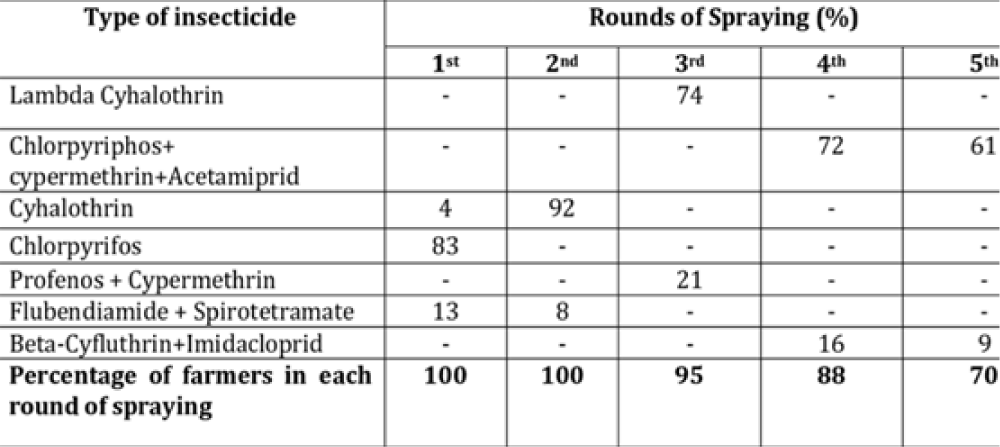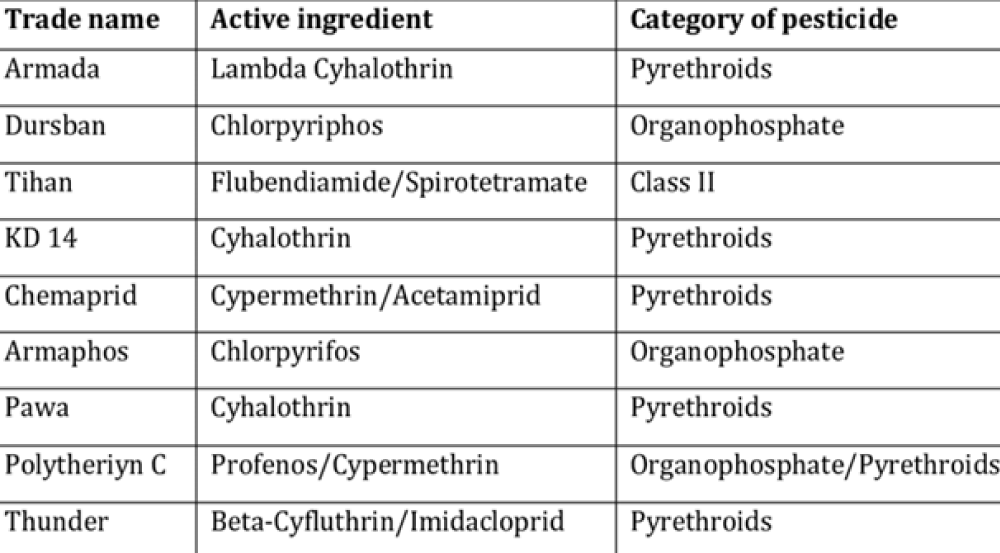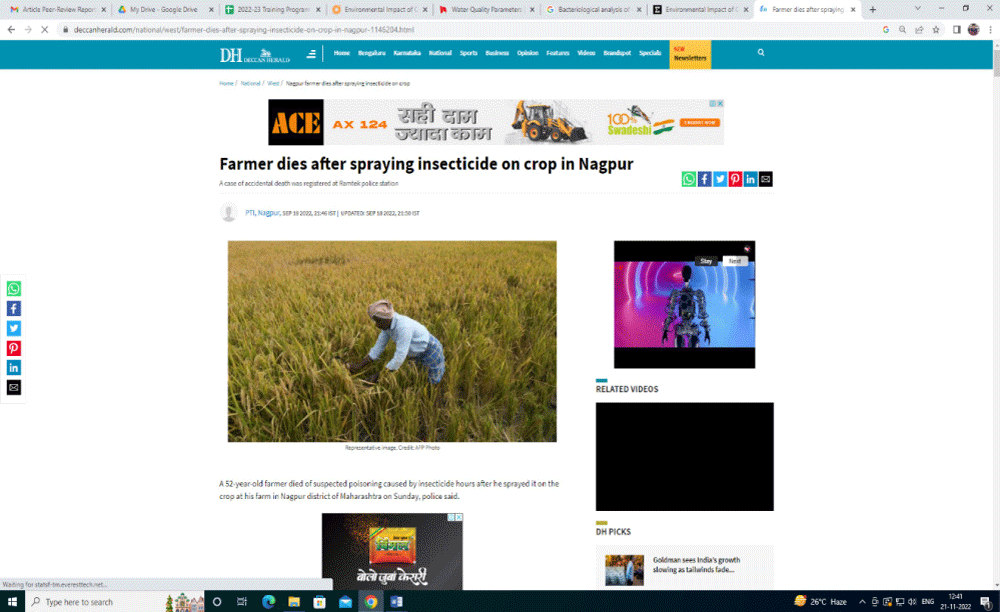More Information
Submitted: November 09, 2022 | Approved: November 21, 2022 | Published: November 22, 2022
How to cite this article: Bhad PR. Biopesticides use on cotton and their harmful effects on human health & environment. Int J Clin Microbiol Biochem Technol. 2022; 5: 005-008.
DOI: 10.29328/journal.ijcmbt.1001025
Copyright License: © 2022 Bhad PR. This is an open access article distributed under the Creative Commons Attribution License, which permits unrestricted use, distribution, and reproduction in any medium, provided the original work is properly cited.
Biopesticides use on cotton and their harmful effects on human health & environment
Pranay Raja Bhad*
Department of Training and Skill Development, Division National Environmental Engineering Research Institute, Nagpur, Maharashtra, India
*Address for Correspondence: MariaPranay Raja Bhad, Department of Training and Skill Development, Division National Environmental Engineering Research Institute, Nagpur, Maharashtra, India, Email: [email protected]
Cotton crop is infested with different kinds of insects in the production cycle. Jassids, thrips, aphids and whiteflies are among the sucking pests, and bollworms (American and spotted) and Spodoptera caterpillars attack leaves and bolls. Bollworms can cause up to 40% - 50% crop losses in severe incidences.
The heavy use of pesticides and synthetic fertilizers harms the environment over time. These toxic chemicals also threaten human health, wildlife, water and soil. Cotton uses 24% and 11% of the world’s insecticides and pesticides, respectively.
Cotton farming, the conventional way, uses a lot of harmful chemicals to control pests and boost production. The heavy use of pesticides and synthetic fertilizers harms the environment over time. These toxic chemicals also threaten human health, wildlife, water, and soil.
Cotton uses 24% and 11% of the world’s insecticides and pesticides, respectively. It also uses 4% of the world’s artificial phosphorus and nitrogen fertilizers [1-3]. Cotton is the third crop with the most pesticide use in India. In 2017 till now, growers used about 48 million pounds in growing cotton. Experts estimate that cotton consumes 8 million tonnes of synthetic fertilizers and 200,000 tonnes of pesticides globally every year.
Out of the top ten pesticides used in cotton farming in 2017 till now, glyphosate, diuron, and tribufos are considered human carcinogens. The rest are potential endocrine disruptors and toxic to bees.
Farmers and people who live close to heavily polluted cotton farms may suffer health injuries caused by toxicity. Glyphosate, in particular, can cause genetic damage and congenital disabilities Scientists genetically modified some cotton species to have certain qualities to increase productivity and profitability. Some of the qualities of genetically engineered cotton include insect resistance and herbicide tolerance.
GMO cotton has been widely accepted all over the world. About 90% of GMO cotton is grown in China, Argentina, Mexico, the United States, Paraguay, Australia, India, Pakistan, and South Africa.
GMO crops may produce high yields, but some types of genetically modified cotton are not great for the environment. In 2017, 10 farmers in the US sued the agricultural biotech company, Monsanto. The farmers claimed that the company’s dicamba-tolerant cotton and soybean crops led to the inevitable, illegal spraying of dicamba herbicide—this extremely volatile herbicide that is prone to drifting, resulting in crop damage and pollution [4,5].
The intensive use of inappropriate insecticides to grow cotton has caused at least 40 weed species to develop resistance to glyphosate. It has also allowed some lepidopteran insects to develop resistance to the protective genes in Bt cotton. There is also a risk of genetically modified gene transfer to wild crops.
To control crops from different pests farmer use various powerful and harmful pesticides like chlorpyriphos, cypermethrin, acetamiprid, etc having contents that which is very harmful to both human health and the environment and directly having the property for causing cancer to human health.
The search was done in electronic databases of PubMed, Scopus, Science Direct, Web of Science, and Google Scholar for studies using the key terms cotton & its polluction on human health and environment, soil polluction in the cotton field which can be cured by bioremediation The inclusion was based reported articles on Biopesticides to use on cotton is carcinogenic to health and environment and more soil pollution cure at some extend with the help of Bioremediation which is discussed in detail. All the data were extracted and explained in respective subheadings.
Chemical pesticide effect on human health Tables 1,2
Table 1:
Table 2:
1. Immunotoxity: Impairs the immune system, and immune suppression, increased chances of infectious disease, and auto-immune disorder, and induces allergic reaction.
2. Respiratory disorder impacts: Damage to the respiratory tract and lung tissues, pulmonary edema, bronchitis, asthma, and cancer.
3. Reproductive Impacts: Reproductive system defects, early puberty, abnormal menstruation cycles, reproductive sperm counts, reduced fertility, infertility, endometriosis, miscarriage, and complications during pregnancy.
4. Hormone disruption: Mimic naturally occurring hormones in the body, damage glands, disrupt hormone function, affects growth and development, sexual development and reproduction, production and utilization of insulin, metabolism disorder, intelligence and behavior, and response to stress.
5. Carcinogenicity: Damage to the respiratory tract and lung tissues, pulmonary edema, bronchitis, asthma, and cancer.
6. Acute health effects: Inching, Burning, headache, blurred vision, nausea, vomiting, fatigue, abdominal discomfort, changes in the heart rate, difficulty breathing, convulsions, peeing and shitting without control, unconsciousness, coma, and death.
7. Neurotoxicity: Cholinesterase inhibition, reduced eye-hand coordinator, reduced memory, lack of neuro-muscular coordination, behavioral change - ADHD, autism, learning disabilities, brain tumors, Alzheimer’s disease, and Parkinson’s disease.
8. Developmental toxicity: Birth defects, malformations, premature births, early infant and child development. In adulthood, reproductive systems abnormalities and related problems, long-term degenerative diseases especially cancer, and various forms of mental disorders.
9. Prenatal origins of hormone disruption due to pesticides: Explosion of adult diseases such as obesity, metabolic diseases, cardiovascular problems, neurological diseases, immune disorders, cancers, autism, attention deficit hyperactivity disorder, learning disabilities, early puberty, breast cancer, endometriosis, polycystic ovary syndrome Tables 3,4.
| Table 3: | |
| Category of pesticides | Number of Pesticides in India |
| Carcinogenic potential | 56 |
| Endocrine/hormone disrupting effect | 81 |
| Immunotoxin effect | 38 |
| Source: Compiled by PAN India. | |
| Table 4: | |
| Highly hazardous pesticides that harm children in India | |
| HHPs harming children | Use type |
| Atrazine, Glyphosate, Paraquat | Herbicide |
| Carbaryl, Chlorpyriphos, Cypermethrin, DDT, Deltamethrin, Dichlorvos , Lambda-cyhalothrin , Malathion , Diazinon, Monocrotophos, Methyl parathion, Permethrin, Propoxur | Insecticide |
| Chlorothalonil, Mancozeb | Fungicide |
Environmental impact of cotton
Cotton is a popular material in the textile industry and the most used natural fiber for manufacturing cloth for our clothes. It accounts for 33% of all fibers used in textiles and is one of the world’s top cash crops. Humans have applied versatile natural fiber to many uses, from fashion to home furnishing and industrial applications. Cotton production employs over 250 million people globally [6-11]. The crop is the most popular, profitable, non-food crop globally, even though it occupies only about 2.5% of its arable land. Growing cotton employs around 7% of the total workforce in developing countries.
Cotton cultivation is vital to the economy; however, it costs the planet. Below are some ways the cotton plant is affecting the environment.
Global warming
Carbon emissions from cotton production amount to around 220 million metric tons yearly. Regular cotton uses a considerable amount of synthetic fertilizers, which release nitrous oxide into the atmosphere. Nitrous oxide is a powerful greenhouse gas 310 times more potent than carbon dioxide.
Soil degradation and erosion
Cotton farms are usually monoculture. And as with monoculture systems sustained for decades, the soil quality suffers degradation. The global area devoted to farming cotton has been more or less constant over the last 70 years. However, exhaustion has led to expansion into new areas. The expansion directly causes deforestation and wildlife habitat loss.
There is also a high risk of topsoil erosion as tree cover is absent on those farms. Erosions can lead to sediment build-up to a dangerous level for aquatic life. Research has proven that high sedimentation in streams and rivers can reduce the density of marine organisms like invertebrates and fish. It can also cause water temperatures to rise and reduce oxygen. Chemical use in cotton growing also harms the soil. It hinders the ability
Cotton farming pollution
Cotton farming, the conventional way, uses a lot of harmful chemicals to control pests and boost production. The heavy use of pesticides and synthetic fertilizers harms the environment over time. These toxic chemicals also threaten human health, wildlife, water, and soil Cotton uses 24% and 11% of the world’s insecticides and pesticides, respectively. It also uses 4% of the world’s artificial phosphorus and nitrogen fertilizers3. Cotton is the third crop with the most pesticide use in the US. In 2017, growers used about 48 million pounds in growing cotton. Experts estimate that cotton consumes 8 million tonnes of synthetic fertilizers and 200,000 tonnes of pesticides globally every year.
Out of the top ten pesticides used in cotton farming in 2017, glyphosate, diuron, and tribufos are considered human carcinogens. The rest are potential endocrine disruptors and toxic to bees.
Scientists have recovered significant amounts of glyphosate in the air and water this is evidence of the mobility of agricultural chemicals from the point of use into the environment. The chemical has also been found in many foods.
Sometimes the clothes and fabric made from chemical-intensive cotton cultivation have traces of pesticides in them. This is a potential health hazard, especially for people with sensitive skin.
More harmful Pesticides are used on Cotton which is very carcinogenic to human health and the Environment. The aim to write this review is Recently Farmers Died while Spraying Pesticides in Nagpur District. To restrict this Problem we can further resolve the problem by using organic pesticides or we can replace the harmful content from the Pesticides. Which will help to restrict the problem of Death of Farmers by replacing the harmful content or carcinogenic content from pesticides.
Clothing is an essential human need, but humans may wear the planet into disastrous climate change without adequate sustainability measures. With all the advantages of organic cotton over conventional cotton, it still struggles to gain competitive consumer acceptance. In 2015, global cotton production was about 26 million metric tonnes, but less than 1% was organic. Sustainability in the textile manufacturing sector is improving; currently, 19% of cotton production globally is organic. However, there is still much more to be done in our move to a more sustainable alternative.
- https://www.researchgate.net/figure/List-of-pesticides-used-by-cotton-farmers_tbl2_308880229
- file:///C:/Users/tsdd/Downloads/Bioremediationpaper.pdf
- Pal SD, Singh CH. Bioremediation of pesticides: A review. AJRSSH. 2021; 419-424.
- https://www.google.com/search?q=chlorpyriphos+B+cypermethrin+Bacetominprid&rlz=1C1ONGR_enIN1017IN1017&oq=chlorpyriphos+B+cypermethrin+Bacetominprid&aqs=chrome..69i57.33686j1j15&sourceid=chrome&ie=UTF-8
- Farmer dies after spraying insecticide on crop in Nagpur. https://www.deccanherald.com/national/west/farmer-dies-after-spraying-insecticide-on-crop-in-nagpur-1146204.html
- https://www.trvst.world/sustainable-living/fashion/environmental-impact-of-cotton/#:~:text=Cottonfarmingpollution&text=Theheavyuseofpesticides,world'sinsecticidesandpesticidesCrespectively.
- FDA In Brief: Final results from FDA’s Pesticide Monitoring Report shows pesticide residues in foods below federal limits. https://www.fda.gov/news-events/fda-brief/fda-brief-final-results-fdas-pesticide-monitoring-report-shows-pesticide-residues-foods-below
- Shrivasthav S. Rains and pests cause huge losses to Vidarbha farmers. 2012. https://timesofindia.indiatimes.com/city/nagpur/rains-and-pests-cause-huge-losses-to-vidarbha-farmers/articleshow/16384314.cms
- The world counts. https://www.theworldcounts.com/challenges/consumption/clothing/environmental-impact-of-cotton-production
- Hikal WM, Baeshen RS, Said-Al Ahl HAH, Ujházy K. Botanical insecticide as simple extractives for pest control. 2017; 1404274. https://www.tandfonline.com/doi/full/10.1080/23312025.2017.1404274
- Pretty J, Bharucha ZP. Integrated Pest Management for Sustainable Intensification of Agriculture in Asia and Africa. https://www.mdpi.com/2075-4450/6/1/152/htm


